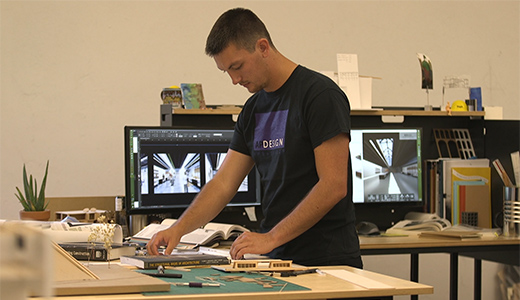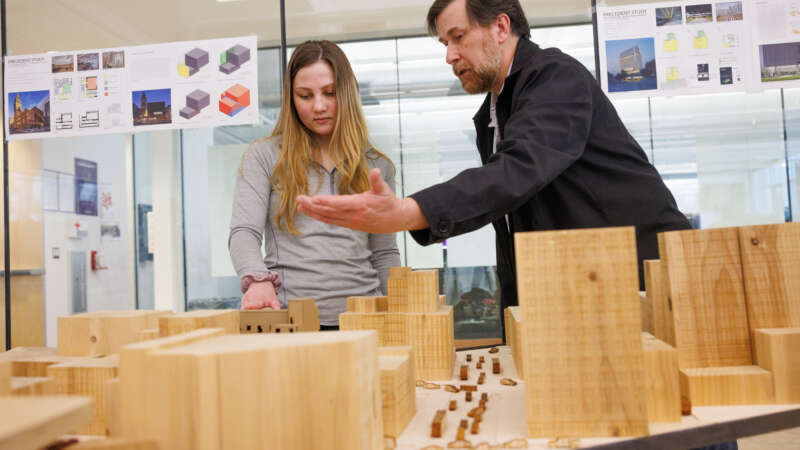Graduate student uses his knowledge of sustainability to create a better tomorrow
Designing a new world is always at the forefront of an architect’s mind. For Grant Urban, a graduate student in the College of Architecture, Planning and Design, the next big wave of new architecture would not be possible without two things: Kansas State University and a focus on sustainability.
“I believe one of the most selfless acts of an architect or community planner is to consciously design with the intent of quality and sustainability. Designing environmentally sensible buildings today for the success of future generations should not be a choice but a priority,” Grant said.
Throughout his time at K-State, Grant has made it his priority to create designs and building plans that incorporate the ideal and practice of sustainability. “I have made it my goal to design every project with a combination of economical, aesthetic, sustainable solutions that will uniquely mitigate its environmental impact,” Grant said.
Grant’s design process begins with five main ideas: 1) sustainable site planning; 2) water conservation and efficiency; 3) energy efficiency and renewable energy; 4) material and resource preservation; and 5) environmentally sensible indoor air and light quality. “It is our responsibility as designers to relay these concerns and priorities to every client, so they may understand their importance and future value to the development of their project,” Grant said.

Relaying the idea of sustainability to clients can be difficult due to a misconception that sustainability is not affordable. That idea of unaffordability is not always the case, according to Grant. “Initial development and construction costs may rise in order to build greener, however choosing not to be sustainable comes at the cost of continued environmental pollution, wasted resources, harmful air emissions, unprecedented water runoff and the cost of quality of life,” Grant said.
None of the new-age designs that Grant and other architecture students are creating would be possible without the support of K-State family and the architecture program.
“APDesign has not only provided the fundamental education I needed to understand the value of sustainable design, but has instilled in me a personal commitment to spread these ideas to others in order to initiate and maintain the priority of green building,” Grant said. “This academic foundation is helping me continue my passion for designing buildings and communities that progressively and innovatively improve the quality of life for its occupants.”
The architecture program at K-State has been ranked among the best in the nation, according to DesignIntelligence, the only organization ranking accredited professional programs in architecture. “K-State is unparalleled for the education it provides for architecture, planning and design students because of its incredible value to the emerging professional,” Grant said. “As one of the least expensive public schools in the state and the country for a nationally accredited degree in architecture, APDesign not only lightens the burden of student debt but persistently ranks high among the most prestigious private architecture schools in the nation.”

Grant also credits his ability to focus on the future of architecture and the planet with the scholarships he has received throughout his time at K-State. “This financial support has allowed me to focus more time and energy on my education without the pressing necessity of part-time work outside of my college curriculum,” Grant said. “The additional time spent on school-related projects has allowed me to refine my process of design and learn more about the realm of sustainable practices in the built environment.”
One of the many benefits of scholarships given to students is the ability to travel abroad. Grant was able to travel to Italy as part of a study abroad journey where he learned about the global scale of sustainable architecture practices and strategies. From this experience, he grew to understand how much his future designs will affect the world.
“Learning from the history of the built environment in other parts of the world, we are able to create modernized and more efficient design solutions that reflect the scale of today’s environmental challenges,” Grant said. “This life-changing experience sparked an even greater passion to implement and relay the importance of sustainable design strategies as a relevant priority to all planners and designers.”
Grant’s goal is to design new buildings with these ideas of sustainability in place. “It would be a realized dream to build a career around the ideals of sustainable practices and historic preservation, and look back on a legacy of work that satisfy clients and communities through designs that positively impact the environment and sustain the health, safety and success of future generations,” Grant said.




